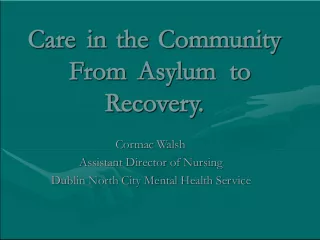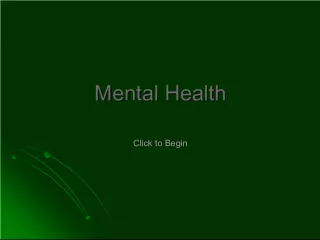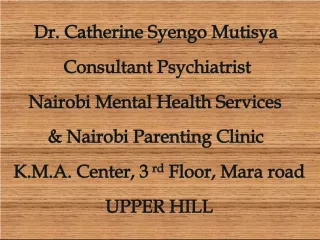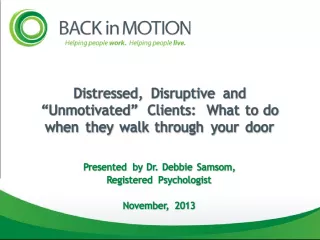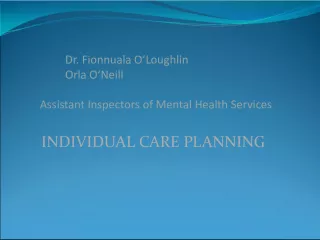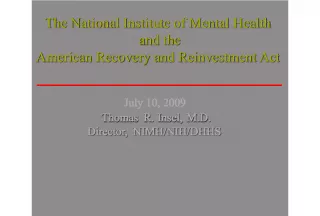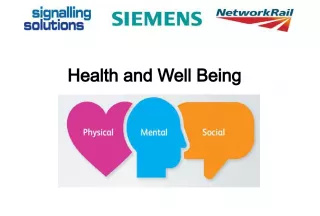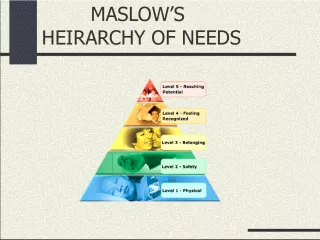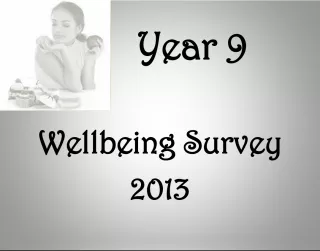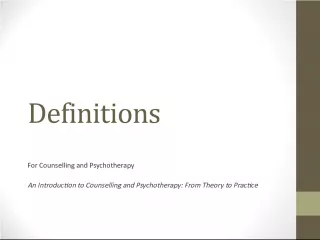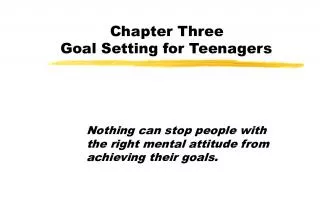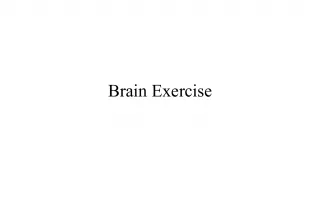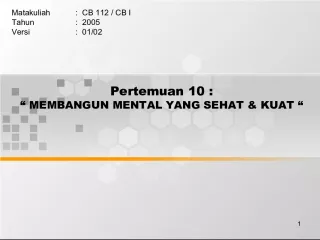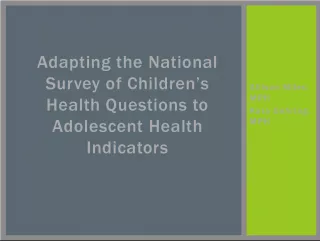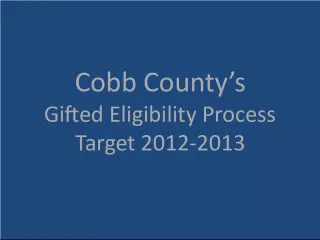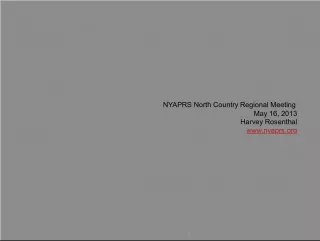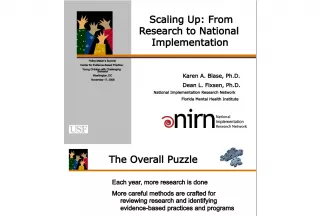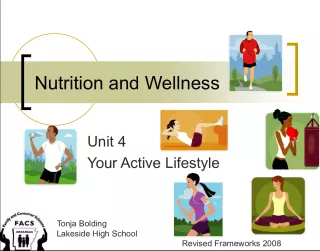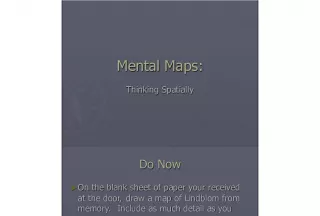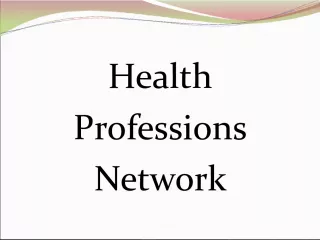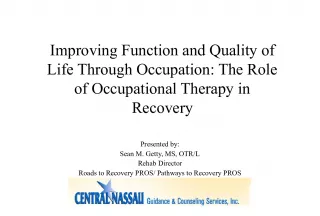Understanding Mental Health in ABE Students


Workshop aims to educate ABE educators on mental health difficulties and signs, provide strategies for supporting students, and identify when to refer students for help.
- Uploaded on | 6 Views
-
 cindyselstad
cindyselstad
About Understanding Mental Health in ABE Students
PowerPoint presentation about 'Understanding Mental Health in ABE Students'. This presentation describes the topic on Workshop aims to educate ABE educators on mental health difficulties and signs, provide strategies for supporting students, and identify when to refer students for help.. The key topics included in this slideshow are . Download this presentation absolutely free.
Presentation Transcript
1. Understanding Adolescent and Adult Mental Health Difficulties in the ABE Classroom Wendy Sweeney, MA Licensed Psychologist PANDA-Minnesota ABE Disability Specialists
2. Workshop Goals Learn about factors that impact mental health and wellness Understand key warning signs and symptoms for early on-set mental illness in adolescents and adults Gain useful strategies to use in the classroom Determine when to refer a student Find out about mental health resources
3. What is Mental Health ? Realistic Thought Processes Stress Management Skills Self Care Ability to Set Social Boundaries Access to a Support Network Healthy Emotional Control
4. What are your perceptions based on?
5. Perception The lens through which we see the world The process by which an individual receives, selects, organizes and interprets information to create a meaningful picture of the world People’s perceptions of a situation, subject, or message affects WHAT they see and hear and HOW they respond
6. Shifting Perceptions Thoughts can be harmful to us when they distort reality or are irrational.
8. The Stressors Many ABE Students Face Financial difficulties Employment difficulties Transportation issues Child care issues Cultural adjustments Few successes Low self worth Limited or poor formal schooling experiences Learning challenges May have a diagnosed or undiagnosed disability May not have access to health care or mental health services
9. The Stigma of Mental Illness Approximately 1 in 4 Americans aged 18 or older suffer from mental illness at some point in their lives It is people you care about, people you respect, people like you The most common mental illness disorders are depression and anxiety From National Institute for Mental Health (NIMH)
10. What is Mental Illness ? Most people feel down or anxious now and then which is NORMAL. When it becomes a reason for concern is when symptoms: Cause emotional distress over an extended period of time Significantly interfere with a person’s ability to function on a daily basis Does not meet social, cultural, or peer expectations. Are present more days than not
11. Causes of Mental Illness Internal Causes External Causes Chemical imbalance Genetics Misinterpretation of information Irrational thoughts and feelings Life changes Traumatic events Childhood difficulties Cultural expectations and/or differences Reactions of others
12. Common Mental Disorders Mood Disorders Major depressive disorder Postpartum depression Seasonal affective disorder (SAD) Bipolar disorder Anxiety Disorders Generalized anxiety disorder Specific phobia Panic disorder Post-traumatic stress disorder
13. What is Depression? Can be a Chemical Imbalance and/or Suppression of Thoughts and Feelings Physical Symptoms Emotional Symptoms Cognitive Symptoms
14. Common Signs of Depression Symptoms are present most of the day, nearly every day for at least 2 weeks: Frequently feeling sad, down or empty Lack of interest in favorite activities Slowed down or restlessness Significant weight loss or gain Loss of energy Feeling guilty or worthless Lack of sleep or sleeping too much Problems concentrating or making decisions Recurrent thoughts of suicide or death
15. What is Anxiety? The Fight or Flight Syndrome Physical symptoms Emotional symptoms Cognitive symptoms
16. Common Signs of Generalized Anxiety Excessive Worry and Difficulty Controlling the Worry occurring more days than not for at least 6 months AND at least 3 of the following symptoms: Muscle tension Difficulty concentrating Sleep disturbance Irritability Easily fatigued Restlessness
17. Anger
18. Treatment Therapy Medication Combination of both
19. Brain Scan of Depression and Anxiety Before treatment for depression and anxiety After treatment for depression and anxiety
20. What is Mental Health ? Realistic Thought Processes Stress Management Skills Self Care Ability to Set Social Boundaries Access to a Support Network Healthy Emotional Control
21. Healthy Coping Strategies Deep breathing Exercise Meditation/Yoga Self care Journaling Take items “off your plate” Say “NO” to obligations when overextended Talk to someone you trust
22. Promoting Mental Health and Wellness in the Classroom
23. Key Warning Signs and Symptoms of Mental Health Difficulties Student appears stressed/overwhelmed There is a noticeable change in student behavior Student is often angry/has outbursts in class Student is often visibly upset/crying Student has inconsistent attendance/not showing up for class/leaving early Student appears emotionally unstable Student appears withdrawn
24. Warning Signs and Symptoms continued… Student is frequently distractible or has trouble concentrating Student complains about being tired or obviously fatigued Student complains about frequent headaches, stomach aches, muscle tension Student smells of alcohol and/or appears drugged Student verbalizes feelings of worthless or makes comments about not wanting to live
25. Suicide Suicidal comments SHOULD NOT be taken lightly! If a student makes comments about not wanting to live TELL SOMEONE call 911 if you feel they may harm themselves and inform someone else who is close to them
26. Behavioral Strategies When a student appears angry or has an outburst, safety is of utmost importance: Remain calm Do not try to argue or reason with the person Tell them to count to ten to cool off Give simple direct instructions. For example: “You need to leave the room now” Put them in a separate room If student is able to calm self down, let them rejoin the classroom; otherwise ask them to come back the next day Call someone for help, if needed
27. Behavioral Strategies continued… When a student appears anxious or stressed: Allow them to take short breaks Tell them to try some deep breathing to relax Encourage them to exercise as a way to relieve tension Offer warm words of encouragement Break information down/limit the number of concepts presented at once to prevent them from feeling overwhelmed Avoid comparing the student to others Ask them to identify their fears or write them down, if they are comfortable
28. Behavioral Strategies continued… When a student appears sad or withdrawn: Pull them aside to express your concerns Ask them if everything is alright Ask them if there is anything you can do for them Provide a special activity that highlights the student’s strengths Give the student genuine compliments Encourage them to talk to someone they trust Let them know you are there for them, if they want to talk
29. When To Refer A Student To A Professional When there is a noticeable CHANGE in student behavior If symptoms have been interfering with the student’s ability to function in the classroom or are disruptive to the class If symptoms cause the student emotional distress over an extended period of time If student’s behavior does not improve or they have difficulty resolving problems after you have attempted behavioral strategies
30. Mental Health Resources Crisis Connection (612) 379-6363 or toll free 1 (866) 379-6363 Free crisis counseling, information and referral services. Seven days a week, 24 hours/day. United Way First Call For Help 1-800-543-7709 Free, confidential and available 24/7 County Mental Health Services: In Minnesota, the county is responsible for providing public mental health services on a sliding fee basis. To find your county contact information go to: http://www.dhs.state.mn.us In the right hand column under Quick Links, click MHCP Provider Directory Suicide Prevention: 612-873-2222; 1-800 784-2433; suicidehotlines.com/Minnesota.html
31. Minnesota ABE Disabilities Website mn.abedisabilities.org
32. Case Studies
33. New Hope Learning Center 8301 – 47 th Avenue North New Hope, MN 55428 Wendy Sweeney, MA, Licensed Psychologist Disability Specialist wendy_sweeney@rdale.org 763-504-4095 Lori Leininger, CBIS Grant Coordinator lori_leininger@rdale.org 763-504-4093
